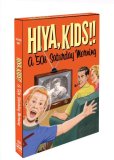| Reviews & Columns |
|
Reviews DVD TV on DVD Blu-ray 4K UHD International DVDs In Theaters Reviews by Studio Video Games Features Collector Series DVDs Easter Egg Database Interviews DVD Talk Radio Feature Articles Columns Anime Talk DVD Savant Horror DVDs The M.O.D. Squad Art House HD Talk Silent DVD
|
DVD Talk Forum |
|
|
| Resources |
|
DVD Price Search Customer Service #'s RCE Info Links |
|
Columns
|
|
|
Hiya Kids! A 50's Saturday Morning Box
The Shout Factory has been releasing some great cult shows recently, and they continue that tradition with Hiya Kids! A 50's Saturday Morning. This four disc set contains 21 kid's shows from the early days of television, and though my Saturday mornings glued in front of the tube were in the 60's and early 70's, I found them marvelously entertaining.
The great thing about this set is that it gives you a taste of a myriad of different shows, and often that's all you need. I'm a big advocate of season sets and eschew 'best of' anthologies, but this set is the exception. Getting to see an episode of Winky Dink and You (a program that has to be seen to be believed) was great, but I wouldn't want a whole disc's worth. The same goes for many of the shows included in this set. Is there anyone besides a TV historian that would really want to see dozens of episodes of Ding Dong School? I think not, but a single helping is quite enjoyable.
This set contains the following shows:
Disc One:
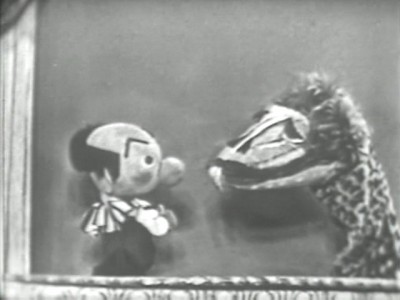 Kukla, Fran and Ollie: The Shout Factory started out the set with one of the best episodes. Ad-libbed, slow, and awkward this early episode is unintentionally hilarious. Kukla is reading in Life Magazine how people's taste can be broken into 'low brow' and 'high brow'. He has a conversation with Fran about the validity of segregating people based on their tastes and cultural likes. (Really, I'm not making this up.) Kukla decides to survey his friends to see if he can categorize them. Asking such questions as who a character's favorite sculptor is, he tries to discover a pattern, with little success.
Kukla, Fran and Ollie: The Shout Factory started out the set with one of the best episodes. Ad-libbed, slow, and awkward this early episode is unintentionally hilarious. Kukla is reading in Life Magazine how people's taste can be broken into 'low brow' and 'high brow'. He has a conversation with Fran about the validity of segregating people based on their tastes and cultural likes. (Really, I'm not making this up.) Kukla decides to survey his friends to see if he can categorize them. Asking such questions as who a character's favorite sculptor is, he tries to discover a pattern, with little success.
As if the subject wasn't bizarre enough (how many kids in the 50's understood cultural classifications much less cared about them) the sponsor was RCA Victor who advertised a radio/record player combo during the show that cost nearly $200! Did they really think kids would have that much scratch or be able to influence their parents buying decision?
The show also wasn't scripted apparently, because there were several awkward pauses when Fran or a puppet didn't know what to say. In one instance Fran started to leave until Kukla called her back. "Oh, yeah, I guess I'll stay here." She says. Filmed live, there weren't any chances for retakes of course. Overall this was a peculiar and hilarious episode that will surely appeal to people with an off kilter sense of humor.
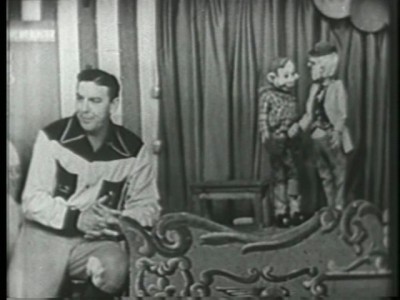 Howdy Doody: One of the most famous and longest-lasting kids shows from the era. Running from 1947 until 1960, the show featured a host, creator Buffalo Bob Smith, puppet Howdy Doody, and Clarabelle the Clown. In this installment, Buffalo and Howdy owe Mr. Bluster 9,950 marbles and he gets tired of waiting for them. He insists on being paid 500 marbles a day. Howdy convinces him that to make a deal however: if the Doody gang can entertain Mr. Bluster, he'll accept that for today's payment.
Howdy Doody: One of the most famous and longest-lasting kids shows from the era. Running from 1947 until 1960, the show featured a host, creator Buffalo Bob Smith, puppet Howdy Doody, and Clarabelle the Clown. In this installment, Buffalo and Howdy owe Mr. Bluster 9,950 marbles and he gets tired of waiting for them. He insists on being paid 500 marbles a day. Howdy convinces him that to make a deal however: if the Doody gang can entertain Mr. Bluster, he'll accept that for today's payment.
The iconic 50's puppet show, this sets the pattern for other kids shows of the era. It's easy to see why it was so popular: there was a good mix of comedy a little bit of continuity, and even a video clip in the middle of the show. It's a fun show that's is still fondly remembered 50 years later.
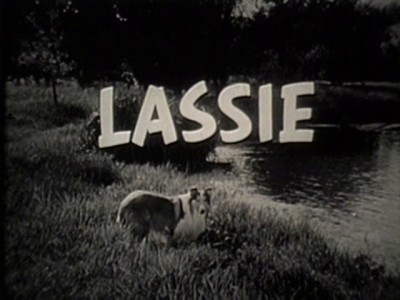 Lassie: Another long-lasting program, this show comes from the earlier seasons and features the original cast of Jeff Miller (Tommy Rettig), his mother Ellen Miller (Jan Clayton) and Jeff's grandfather Gramps (George Cleveland). In this episode, Jeff and a friend, Porky, become blood brothers and then they build a tree house and decide to sleep there. In the middle of the night the two boys get in a fight and Porky leaves. The next day, Jeff discovers Porky near the tree house, which has been trashed. Did Jeff's blood brother really wreck the tree house? It's up to Lassie to discover the truth.
Lassie: Another long-lasting program, this show comes from the earlier seasons and features the original cast of Jeff Miller (Tommy Rettig), his mother Ellen Miller (Jan Clayton) and Jeff's grandfather Gramps (George Cleveland). In this episode, Jeff and a friend, Porky, become blood brothers and then they build a tree house and decide to sleep there. In the middle of the night the two boys get in a fight and Porky leaves. The next day, Jeff discovers Porky near the tree house, which has been trashed. Did Jeff's blood brother really wreck the tree house? It's up to Lassie to discover the truth.
Annie Oakley: The famous western character comes to life on the small screen staring Gail Davis as the sharp-shooting woman. A nice western full of action and with a good plot, this story involves a murdered telegraph operator and a cross-country bicycle race. While it wasn't much different from the other kid's TV westerns of the day, even though the lead was female, it's an entertaining show.
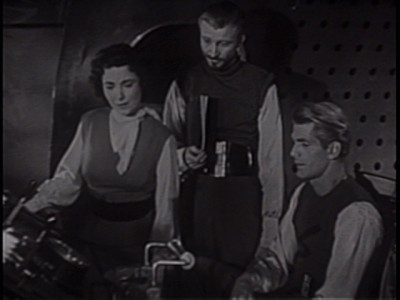 Flash Gordon: Based on the popular comic strip, this show only lasted a single season, which is a little surprising. Though the production values were very low, they weren't significantly inferior to some of the other shows in this set. Oddly enough, this was an international co-production and was filmed in West Germany. In this episode, one of the last in the series, Dale, Flash, and Dr. Zarkov have to travel back in time 1250 years to 20th Century Earth. A bomb has been planted in this time period that will destroy the Earth of the future if they don't defuse it in 30 minutes. The bomb is traced to Berlin, and the trio race through the city looking for the explosive. It was interesting to see post-war Berlin as they traveled through the city. There were still many bombed out buildings to be sene. The most humorous part was seeing Berlin Policemen chasing Flash and the rest through Berlin in an unmarked VW Bug. The show wasn't nearly as engaging as the serials, but it had a certain charm.
Flash Gordon: Based on the popular comic strip, this show only lasted a single season, which is a little surprising. Though the production values were very low, they weren't significantly inferior to some of the other shows in this set. Oddly enough, this was an international co-production and was filmed in West Germany. In this episode, one of the last in the series, Dale, Flash, and Dr. Zarkov have to travel back in time 1250 years to 20th Century Earth. A bomb has been planted in this time period that will destroy the Earth of the future if they don't defuse it in 30 minutes. The bomb is traced to Berlin, and the trio race through the city looking for the explosive. It was interesting to see post-war Berlin as they traveled through the city. There were still many bombed out buildings to be sene. The most humorous part was seeing Berlin Policemen chasing Flash and the rest through Berlin in an unmarked VW Bug. The show wasn't nearly as engaging as the serials, but it had a certain charm.
Disc Two:
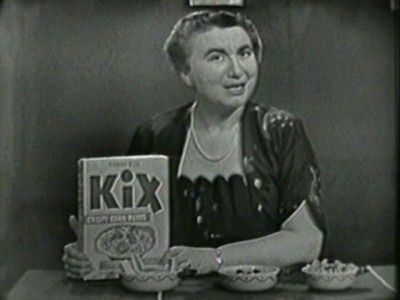 Ding Dong School: This weekday show aimed at pre-school children is hosted by the matronly Miss Frances (Dr. Frances R. Horwich) who was obviously the inspiration for Fred Roger's show. She talks to the children as real people, asks them questions, and gives them advice. In this episode she plays with bubbles, reads some poems, and shows the children how to make things with a handkerchief. If you don't have memories of this show, it will probably prove a bit slow but I'm sure it entertained many a child in the 50's.
Ding Dong School: This weekday show aimed at pre-school children is hosted by the matronly Miss Frances (Dr. Frances R. Horwich) who was obviously the inspiration for Fred Roger's show. She talks to the children as real people, asks them questions, and gives them advice. In this episode she plays with bubbles, reads some poems, and shows the children how to make things with a handkerchief. If you don't have memories of this show, it will probably prove a bit slow but I'm sure it entertained many a child in the 50's.
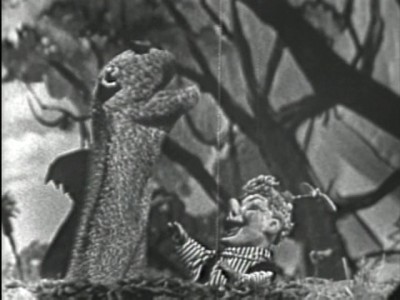 Time for Beany: One of the original live-action Beany and Cecil shows, this puppet show doesn't have the same format as the other ones in this set. Rather than having a live adult interact with the puppets in a variety show fashion, this program tells a comedy/drama/adventure story. In this episode, Beany, Cecil, and the Captain have traveled past Tim Buck's Tooth, through Nothing Atoll, and have finally reached the 5th Corner of the World. They're looking for a giant white ape, but the group gets separated and Beany ends up in a native's pot over a fire.
Time for Beany: One of the original live-action Beany and Cecil shows, this puppet show doesn't have the same format as the other ones in this set. Rather than having a live adult interact with the puppets in a variety show fashion, this program tells a comedy/drama/adventure story. In this episode, Beany, Cecil, and the Captain have traveled past Tim Buck's Tooth, through Nothing Atoll, and have finally reached the 5th Corner of the World. They're looking for a giant white ape, but the group gets separated and Beany ends up in a native's pot over a fire.
I fondly remember the Beany and Cecil cartoon, and found this show just as entertaining. It's funny, filled with groan-inducing puns, and was held together by a decent story. Probably my favorite episode in this collection, I could easily watch a season of this without getting tired. I can't say the same thing for Super Circus or Ding Dong School.
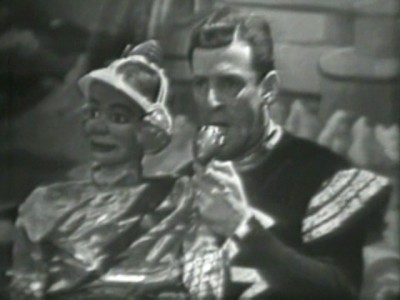 The Paul Winchell Show: Before he was the voice of everyone's favorite Tigger, Paul Winchell had a successful and diverse TV career. He was a self-taught ventriloquist, creator of Jerry Mahoney and the dim-witted Knucklehead Sniff. He first appeared on TV in 1948, hosting a variety show, and would be on the air in one show or another until 1960, and sporadically after that. He stared in one of the first Saturday morning kid's shows in 1954, the Winchell and Mahoney Show. Oddly enough, an episode from that show is not included. This show, hosted by Cheer and Camay ("The soap of beautiful women"), was obviously not Saturday morning fare, though it is entertaining. Paul is stuck watching a neighbor's young girl, so he gets out Jerry Mahoney to entertain her. The girl starts telling her version of "A Christmas Carol" and while she does, Paul remembers, and imagines, various Christmas' in the past, present, and future. The future version took place in the far off year of 2000, where Paul takes a vacation on the moon. The banter between Paul and Jerry was much more humorous that the jokes in the other shows, and he had a good sense of humor and timing. A funny show.
The Paul Winchell Show: Before he was the voice of everyone's favorite Tigger, Paul Winchell had a successful and diverse TV career. He was a self-taught ventriloquist, creator of Jerry Mahoney and the dim-witted Knucklehead Sniff. He first appeared on TV in 1948, hosting a variety show, and would be on the air in one show or another until 1960, and sporadically after that. He stared in one of the first Saturday morning kid's shows in 1954, the Winchell and Mahoney Show. Oddly enough, an episode from that show is not included. This show, hosted by Cheer and Camay ("The soap of beautiful women"), was obviously not Saturday morning fare, though it is entertaining. Paul is stuck watching a neighbor's young girl, so he gets out Jerry Mahoney to entertain her. The girl starts telling her version of "A Christmas Carol" and while she does, Paul remembers, and imagines, various Christmas' in the past, present, and future. The future version took place in the far off year of 2000, where Paul takes a vacation on the moon. The banter between Paul and Jerry was much more humorous that the jokes in the other shows, and he had a good sense of humor and timing. A funny show.
The story ends with a sad note post script. In 1965 Paul started in Winchell-Mahoney Time, a daily kid's show that ran for three years and 288 episodes. In 1986, Winchell clashed with Metromedia over the syndication rights to those shows. Most of his other programs were shown live, and this series was the only lasting record of his talent. Instead of coming to an agreement with the ventriloquist however, Metromedia wiped all of the tapes, destroying the chance for future generations to enjoy his work. Winchell sued and was awarded $17.8 million.
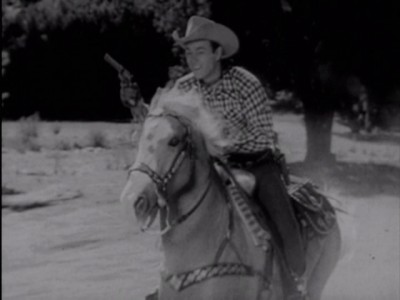 The Roy Rogers Show: One of the most popular TV cowboys, Roy Rogers was known as the "King of the Cowboys." Along with his real-life wife Dale Evans, his horse Trigger, and Bullet the wonder dog, Roy would keep the west safe from no-goodniks. In this episode a villain gets the drop of Roy and kidnaps him. Not for ransom or to kill him, but so that Roy could track down a missing horse. Luckily Roy was able to leave a vague clue on a checker board, but that's all Bullet needed to track down his master.
The Roy Rogers Show: One of the most popular TV cowboys, Roy Rogers was known as the "King of the Cowboys." Along with his real-life wife Dale Evans, his horse Trigger, and Bullet the wonder dog, Roy would keep the west safe from no-goodniks. In this episode a villain gets the drop of Roy and kidnaps him. Not for ransom or to kill him, but so that Roy could track down a missing horse. Luckily Roy was able to leave a vague clue on a checker board, but that's all Bullet needed to track down his master.
Honestly, the westerns in this set (there's one on every disc) started to run together. They all had similar settings and problems for the hero to overcome. This aspect that set this show apart is that they weren't in the old west. Apparently it was a contemporary show because Roy's side-kick drove a jeep. Why everyone chose to ride horses from town to town (or to use them in a hold-up as this episode's antagonist does) is beyond me.
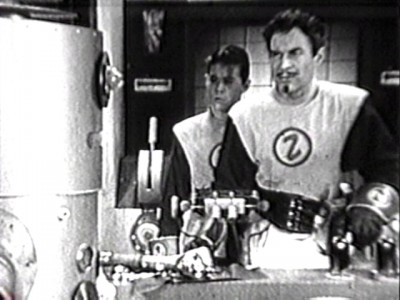 Captain Z-Ro: Like Flash Gordon, this was a very low budget Sci-Fi show that I really enjoyed. Located in a hidden laboratory somewhere on Earth, Captain Z-Ro (pronounced "Zero") performed experiments in time and space. This episode is apparently atypical of the series, most of which had a historical aspect to them. In this adventure Z-Ro invents a robot and transports it to Mercury to investigate the planet since no man can withstand the pressure on the surface. Unfortunately a lightning strike right at the minute of transportation sends the robot to San Francisco instead of Mercury and scrambles its electronic brain. Much of the show is taken up watching the robot walk around SF and occasionally causing trouble. Though the production values were very low (it looks like it was filmed in someone's decorated garage) the show had a lot of spirit and was fun to watch.
Captain Z-Ro: Like Flash Gordon, this was a very low budget Sci-Fi show that I really enjoyed. Located in a hidden laboratory somewhere on Earth, Captain Z-Ro (pronounced "Zero") performed experiments in time and space. This episode is apparently atypical of the series, most of which had a historical aspect to them. In this adventure Z-Ro invents a robot and transports it to Mercury to investigate the planet since no man can withstand the pressure on the surface. Unfortunately a lightning strike right at the minute of transportation sends the robot to San Francisco instead of Mercury and scrambles its electronic brain. Much of the show is taken up watching the robot walk around SF and occasionally causing trouble. Though the production values were very low (it looks like it was filmed in someone's decorated garage) the show had a lot of spirit and was fun to watch.
Disc Three:
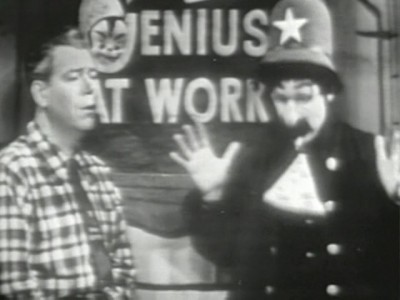 Rootie Kazootie: Another puppet show. This one imitated Howdy Doody very heavily. With a similar stage including an all-children audience who sing the opening song, Rootie Kazootie has a human host, Big Todd Russell, and a police-clown Mr. Deetle Doodle who never spoke, much like Clarabelle. In this episode the villain, Poison Sumac, has a super-powerful magnet that can attract anything. He causes a lot of trouble until Rootie comes up with a plan to get the magnet away from Sumac. The show moved much quicker than Howdy Doody, zipping from one skit or song to the next and had a lot of energy.
Rootie Kazootie: Another puppet show. This one imitated Howdy Doody very heavily. With a similar stage including an all-children audience who sing the opening song, Rootie Kazootie has a human host, Big Todd Russell, and a police-clown Mr. Deetle Doodle who never spoke, much like Clarabelle. In this episode the villain, Poison Sumac, has a super-powerful magnet that can attract anything. He causes a lot of trouble until Rootie comes up with a plan to get the magnet away from Sumac. The show moved much quicker than Howdy Doody, zipping from one skit or song to the next and had a lot of energy.
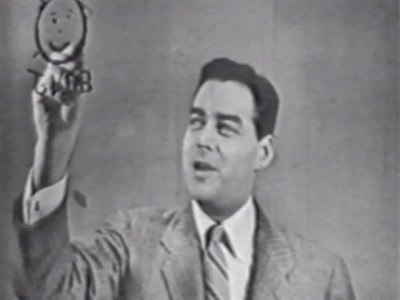 Winky Dink And You: One of the most creative, but yet bad, ideas to come out of early TV. Hosted by Jack Barry (who would later go on to co-produce the game show Twenty-One which led to scandal and congressional action when it was discovered that contestants were given the answers to the questions) this was the first interactive TV show. Children could send in 50 cents (a significant sum for a child in those days) for a "Magic Winky Dink Kit" that allowed them to participate in the show. The Kit contained a plastic sheet that kids were supposed to place on their TV screen and then use the included crayons to draw on the plastic following Jack's fingers which trace out shapes. I can only imagine how many children who didn't have the magic kit decided to draw right on the picture tube. Oddly enough, the host never warned the kids not to do that (in this show at least).
Winky Dink And You: One of the most creative, but yet bad, ideas to come out of early TV. Hosted by Jack Barry (who would later go on to co-produce the game show Twenty-One which led to scandal and congressional action when it was discovered that contestants were given the answers to the questions) this was the first interactive TV show. Children could send in 50 cents (a significant sum for a child in those days) for a "Magic Winky Dink Kit" that allowed them to participate in the show. The Kit contained a plastic sheet that kids were supposed to place on their TV screen and then use the included crayons to draw on the plastic following Jack's fingers which trace out shapes. I can only imagine how many children who didn't have the magic kit decided to draw right on the picture tube. Oddly enough, the host never warned the kids not to do that (in this show at least).
Super Circus: Everyone loves the circus, so why not bring it into people's homes? This show featured two circus acts, acrobats and trapeze artists in this episode, with a clown act in the middle. The clown show was pretty amusing, and the circus acts must have been pretty exciting to kids in the 50's and is even entertaining today.
Andy's Gang: Sponsored by Buster Brown Shoes, this show was hosted by Andy Devine who viewers will instantly recognize as "Cookie" from the Roy Rogers westerns. The show featured serialized adventures that Andy 'read' from a book. This episode features a Little Fox story, about young Indian who is learning to be a Brave. Following that, which takes up the lion's share of the show, Andy talks to his friend Froggy the Gremlin who brings his cousin, an orangutan, to the show. Everyone ends up dancing to the monkey's tunes. While the Little Fox story was entertaining, the rest of the show was pretty lame, truth be told.
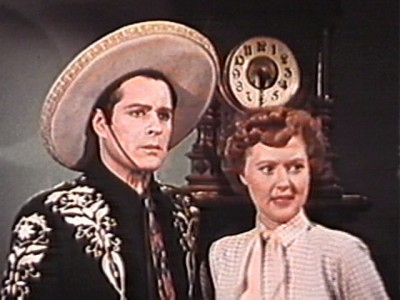 The Cisco Kid: At one time his popularity rivaled that of the Lone Ranger, but today, the Cisco Kid is almost forgotten. Like the Ranger, the Cisco Kid rode through the old west with his faithful sidekick, Pancho, righting wrongs and protecting the innocent. Never staying around after his job was finished; he'd ride off into the sunset on his horse Diablo, off looking for more adventure. This time he helps a woman he discovers in the desert survive a series of assassination attempts as well as discover where her inheritance is hidden. This program, broadcast in color, was just as entertaining as the other western in this set.
The Cisco Kid: At one time his popularity rivaled that of the Lone Ranger, but today, the Cisco Kid is almost forgotten. Like the Ranger, the Cisco Kid rode through the old west with his faithful sidekick, Pancho, righting wrongs and protecting the innocent. Never staying around after his job was finished; he'd ride off into the sunset on his horse Diablo, off looking for more adventure. This time he helps a woman he discovers in the desert survive a series of assassination attempts as well as discover where her inheritance is hidden. This program, broadcast in color, was just as entertaining as the other western in this set.
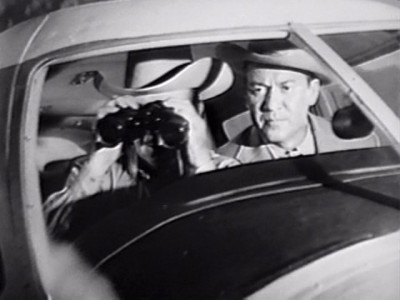 Sky King: Today, it's kind of hard to see the appeal of this show. Basically Schuyler "Sky" King owned the Flying Crown Ranch. He wasn't a great shot like Annie Oakley or a famous tracker like Roy Rogers. He wasn't a wandering do-gooder like The Lone Ranger or The Cisco Kid, and he wasn't even youthful like Sheena, Queen of the Jungle. No, Sky's big selling point was this: he owned an airplane. When a hiker was lost, or a seeing-eye dog chases a crook into the desert (as happens in this episode), King takes to the air and looks from his plane, the Songbird. I could maybe see it if they had given the plane a more macho name, like the Razor Fist, but they didn't. The plane wasn't even armed. In any case this story about a blind boy whose dog runs off after a crook didn't have much suspense or excitement, and even the supposedly suspenseful ending, where the dog might have gone wild and have to be killed, lacked punch.
Sky King: Today, it's kind of hard to see the appeal of this show. Basically Schuyler "Sky" King owned the Flying Crown Ranch. He wasn't a great shot like Annie Oakley or a famous tracker like Roy Rogers. He wasn't a wandering do-gooder like The Lone Ranger or The Cisco Kid, and he wasn't even youthful like Sheena, Queen of the Jungle. No, Sky's big selling point was this: he owned an airplane. When a hiker was lost, or a seeing-eye dog chases a crook into the desert (as happens in this episode), King takes to the air and looks from his plane, the Songbird. I could maybe see it if they had given the plane a more macho name, like the Razor Fist, but they didn't. The plane wasn't even armed. In any case this story about a blind boy whose dog runs off after a crook didn't have much suspense or excitement, and even the supposedly suspenseful ending, where the dog might have gone wild and have to be killed, lacked punch.
Disc Four:
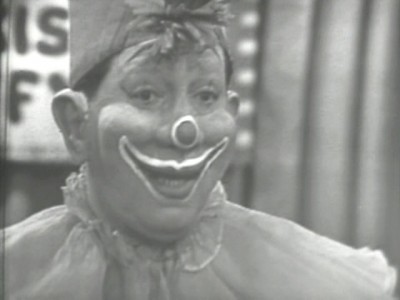 The Magic Clown: There are two episodes of this 15 minute show, each one with a different Magic Clown. I enjoyed the first one a bit more, but both were fun. In this program the Magic Clown would sing the opening song, do a trick, hawk Bonamo's Turkish Taffy, and then sign off. This was fun to watch and the tricks were okay for a kids show. The high point in these two episodes was when the Clown had three children pick a card that he can't see. When he went to ask the second child what her card was, she couldn't remember it at all, just shaking her head and staring blankly at the performer. The clown says "What? Did you say the 8 of Clubs?" (the card she picked and he hadn't seen) and then finishes the trick. An enjoyable entry.
The Magic Clown: There are two episodes of this 15 minute show, each one with a different Magic Clown. I enjoyed the first one a bit more, but both were fun. In this program the Magic Clown would sing the opening song, do a trick, hawk Bonamo's Turkish Taffy, and then sign off. This was fun to watch and the tricks were okay for a kids show. The high point in these two episodes was when the Clown had three children pick a card that he can't see. When he went to ask the second child what her card was, she couldn't remember it at all, just shaking her head and staring blankly at the performer. The clown says "What? Did you say the 8 of Clubs?" (the card she picked and he hadn't seen) and then finishes the trick. An enjoyable entry.
Kids And Company: Okay, this show was obviously aimed at turning the horrible tide of juvenile delinquency that everyone was worried about in the 50's. Staring "The Kids of America" this was a talent show for kids. Each show they'd spotlight a child who saved someone's life or helped out a charity. In this particular episode they crown the kid of the year. One interesting thing about this program is that it was hosted by Johnny Olsen who would go on to have a very successful career as a TV announcer.
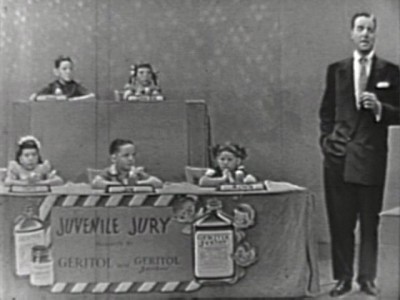 Juvenile Jury: Hosted by Jack Barry (see Winky Dinky and You) this show was a precursor to Art Linkletter's "Kids Say the Darndest Things" segment on House Party (this show started 3 years earlier.) The premise was simple; five kids between the ages of 3 and 12 would be presented with a dilemma, something simple like should someone's father buy a new car, and give their opinions. It's quite hilarious hearing at times and some Barry does a great job at putting the children at ease and coaxing outrageous statements from them. I found myself laughing to this more than any other show in the set.
Juvenile Jury: Hosted by Jack Barry (see Winky Dinky and You) this show was a precursor to Art Linkletter's "Kids Say the Darndest Things" segment on House Party (this show started 3 years earlier.) The premise was simple; five kids between the ages of 3 and 12 would be presented with a dilemma, something simple like should someone's father buy a new car, and give their opinions. It's quite hilarious hearing at times and some Barry does a great job at putting the children at ease and coaxing outrageous statements from them. I found myself laughing to this more than any other show in the set.
The Pinky Lee Show: Pinky Lee started out in burlesque and he brought a very kinetic and fast paced persona to the show. Mugging it up with the kids and adults in the audience, things happen much more quickly in this show than the other children's variety shows on at the time. Pinky was a great performer and even adults will get a laugh out of his antics. He does things that you couldn't get away with on TV today, such as when he sits on a mother's lap and kisses her. Nowadays he'd be fired quicker than you could say "sexual harrasement." The show only ran two years, but it looks like it was quite a ride.
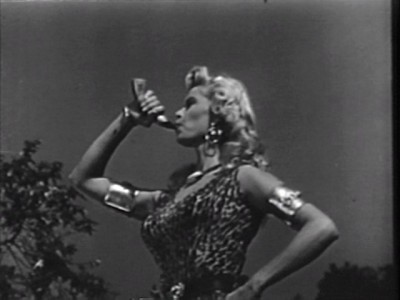 Sheena, Queen of The Jungle: Okay, let us get this out of the way: Sheena is HOT! Portrayed by model Irish McCalla, the tall, thin, toned, blonde is a knock out. I'm sure that more than a few fathers would wander into the television room to check on what the kids were doing while Sheena was on.
Sheena, Queen of The Jungle: Okay, let us get this out of the way: Sheena is HOT! Portrayed by model Irish McCalla, the tall, thin, toned, blonde is a knock out. I'm sure that more than a few fathers would wander into the television room to check on what the kids were doing while Sheena was on.
In the show, Sheena was pretty much a female Tarzan; she speaks in broken English, swings through the trees, and has a pet monkey. In this episode some escaped convicts try to start a war between to friendly native tribes and it's up to Sheena to foil their plans. While this show wasn't terribly different from the westerns of the time, even though it was set in Africa, it did have a strong female lead, something that was rare at the time.
The DVD:
Audio: These shows are all presented with their original mono soundtracks. None of these programs have been restored, so hiss and pops are common place and some dropouts and distortion (especially when the kids in the audience scream at the beginnings of shows) is to be expected. With only one or two exceptions however the show are easy to listen to. Juvenile Jury is one show that has a lot of noise and distortion however, and sometimes it's hard to hear what the children are saying.
Video: All of these shows are presented in their original full screen glory and are black and white (with one exception: The Cisco Kid is in color.) Like the audio, there are a fair number of defects in the video presentations. Just about all of the shows have dirt, scratches and other print defects. the images are generally soft, and the black levels are nothing to write home about. Detail ranges from average to not so great. Colors on Cisco Kid were a bit faded and had a tendency to bleed too, but it wasn't that bad. There were a couple of shows that looked good, but there were also a couple that left a lot to be desired. Captain Z-Ro was in pretty bad shape, and Kids and Company was so contrasty that it was hard to watch. All the details were gone and the whites bloomed and took over the image.
Extras: Unfortunately the only extra is a 16-page booklet with some information about these shows.
Final Thoughts: I thought I would like this set, but I'm surprised at how much I enjoyed it. Sitting through a disc every night before bed, I had to force myself not to pop in the next DVD. If I had I'd surely have stayed up another couple of hours watching it all. While some of the shows weren't that great, it was still enjoyable to see what choices kids of the 50's had. For those of you who grew up during this era, the set is a no-brainer, go out and pick it up.
My kids, however, weren't impressed by the episodes that they screened with me, but this set isn't really aimed at them. Ever since they could walk they've had 100 different cable channels and a DVR at their finger tips. If you remember a time, not so long ago, when the only chance to see children's programming was on Saturday morning however, this set is for you. This is a wonderful collection of shows from a simpler era that's well worth watching. Highly Recommended.
|
| Popular Reviews |
| Sponsored Links |
|
|
| Sponsored Links |
|
|
| Release List | Reviews | Shop | Newsletter | Forum | DVD Giveaways | Blu-Ray | Advertise |
|
Copyright 2024 DVDTalk.com All Rights Reserved. Legal Info, Privacy Policy, Terms of Use,
Manage Preferences,
Your Privacy Choices | |||||||









